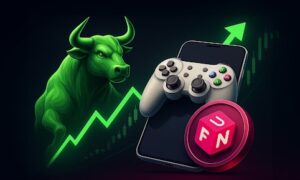Zak Westphal is on a mission – to empower regular investors in a market increasingly dominated by high-speed algorithms and institutional players. As the founder of StocksToTrade, he challenges assumptions that sophisticated trading strategies are reserved for Wall Street elite.
Through an intuitive platform, Zak puts robust analytics, predictive AI, and algorithmic capabilities into retail traders’ hands. As a result, a community of over 30,000 members now leverages tools once exclusive to wealthy institutions. StocksToTrade helps level the playing field by unlocking complex methodologies and tirelessly analyzing opportunities at speeds rivaling the most advanced quantitative systems.
But Zak isn’t just an innovator in the finance space. He represents a new breed of fintech leaders focused on inclusion rather than exclusion. His vision is to help everyday investors grab a seat at tables occupied by hedge fund titans and private equity firms. Rather than rail against a system tilted against the little guy, he aims to arm individuals with the knowledge and tech to compete on their own terms.
Q1. What originally inspired you to found StocksToTrade?
I founded StocksToTrade to fill a gap I saw in the industry. Lots of platforms existed as fancy calculators – offering tools without much guidance on strategies. From painful experience, I knew firsthand how lost new traders felt trying to find winning stocks in the haystack.
I wanted to build something user-friendly that did more heavy lifting so traders could actually spend time well…trading smartly.
The lightbulb moment happened when I met my eventual StocksToTrade cofounder Tim Sykes. Watching him teach trading patterns he’d mastered for years, I realized the magic sauce was embedding that hard-earned experience right into technology.
Instead of just crunching numbers, our algorithms would mirror the systems proven to generate growth. That way, subscribers could instantly apply battle tactics that had been perfected over many months and years.
I wanted to demystify algorithmic trading coming from institutions and make it accessible for ordinary investors. The goal was to design everything intuitively so newcomers could leverage the same powerful technologies as seasoned experts.
Q2. How does StocksToTrade aim to empower retail investors – what core beliefs or philosophies guide your approach?
Our central belief is that ordinary investors deserve access to technologies and opportunities long guarded by institutional players. For too long, retail participation meant bringing a knife to a gun fight. StocksToTrade aims to arm individuals with weapons to compete on more equal footing.
We focus on amplification over automation – handling tedious tasks so traders can focus on strategy. Our algorithms provide recommendations but still allow manual overrides based on risk appetite.
Above all, we listen to user needs instead of lecturing what Wall Street deems appropriate. Our community guides product evolution through feedback fueling constant betterment. We succeed only when our customers succeed. Our goal is strategically educating self-directed learners so they can leverage institutional-grade capabilities customized to their investing goals.
Q3. Can you explain some of StocksToTrade’s main features and how they benefit users?
At the core of StocksToTrade, we aim to provide traders access to powerful technologies along with the education to use them effectively. I think that combination is key.
So for example, one of our most popular features is the Oracle Scanner – this proprietary algorithm constantly filters through stocks to identify advantageous trade setups users can review and execute. The benefit is it distills complex analysis traders would struggle replicating manually into a simple dashboard of curated ideas.
Another great tool is IRIS Analytics. IRIS leverages AI to generate unbiased stock assessments blending both technical and fundamental perspectives. This allows traders to make more informed swing trade decisions based on the stock ratings and reports.
We also have great features like News Sentiment Analysis which goes beyond just keyword scanning to provide nuanced interpretations of how market news events may impact particular stocks. And a major bonus is that all these advanced tools are wrapped in intuitive interfaces so less technically-savvy traders can still leverage institutional-grade resources.
Q4. What role does education play in your business model and product offerings?
Education is hugely important – because technology alone can’t guarantee trading success. Our tools provide a vital edge, but traders still need the knowledge to leverage them strategically. That’s why we embed educational resources across the user experience – from intro tutorials to explain tools, to entire courses unlocking advanced quantitative methodologies.
Users aren’t just accessing black-box algorithms – we teach the logic behind the formulas so they deeply understand strategies. We offer discussion groups and even one-on-one mentorships so members can engage with our trainer team to refine unique plans tailored to individual risk appetites.
The end goal of comprehensive education paired with robust tools is building user independence over the long term. We aim for members to find what specifically works for them so they can ultimately trade profitably even without our technology as a crutch.
Q5. Where do you see the biggest opportunities to keep innovating in algorithmic trading?
While we’ve made huge strides, algorithmic trading is still in its early phases in terms of mass adoption. I see major headroom to keep improving user experience and personalization. There are infinite ways to blend automation with human oversight that haven’t been explored.
For example, augmenting analysis with conversational AI that can interpret natural language prompts could make finding profitable trades more intuitive. And adaptive machine learning models that customize strategies based on evolving user behavior patterns can enhance performance.
Overall, I think the biggest innovation opportunities center on using technology to simplify complexity rather than pursue complexity for its own sake. The end goal should be accessibility allowing more retail traders to implement institutional-grade algorithms. So innovation efforts should focus on education and amplification over just automation alone.
Q6. What advice would you give to those looking to get started in trading today?
If I had to break it down, step one is not leaping into the deep end on day one! Take time upfront to study proven trading strategies – don’t wing it hoping to get lucky. Paper trade a ton before risking real capital so you can master the mental game too.
Set reasonable profit targets and stop losses based on your unique money situation – don’t copy what works for millionaires if you’re living paycheck to paycheck. Start slow. Pick user-friendly tech to simplify your process rather than over-complicates things.
Oh, and be patient in your education. Reflect on slip-ups to turn mistakes into lessons instead of compounding errors. Stay disciplined, sticking to your trading parameters once established instead of revenge trading. Profitable trading is a lifelong endeavor, not a get rich quick scheme.

































